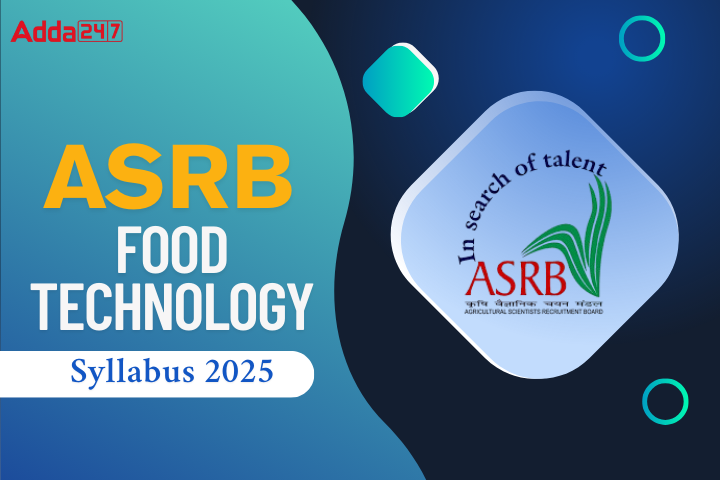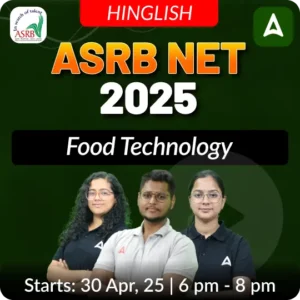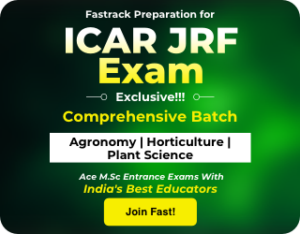The Agricultural Scientists Recruitment Board conducts the National Eligibility Test to assess candidates’ eligibility in Agricultural Universities nationwide. Among the various disciplines offered, food technology is a prominent field that focuses on the processing, preservation, and quality control of food products. Understanding the ASRB NET Food Technology Syllabus 2025 is important for aspirants aiming to excel in this competitive examination.
ASRB NET Food Technology Syllabus 2025
The ASRB NET Food Technology Syllabus 2025 is divided into 8 units: Introductory Food Technology, Technology of Foods of Plant Origin, Technology of Foods of Animal Origin, Food Quality Management, Food Engineering/Packaging and Labelling, Food Microbiology and Biotechnology, Flavour Chemistry Technology and Consumer Sciences, and Food Product Development. In this article, we have discussed each unit of the ASRB NET Food Technology Syllabus in detail.
ASRB NET Food Technology Syllabus: Overview
The table below presents a quick overview of the ASRB NET Food Technology Syllabus 2025 for candidates preparing for the ASRB NET Exam 2025 and have chosen Food Technology as their discipline.
| ASRB NET Food Technology Syllabus | |
|---|---|
| Organization | Agricultural Scientists Recruitment Board |
| Exam Name | ASRB NET Exam 2025 |
| Post | Assistant Professors and Lecturers |
| Exam Level | National |
| Frequency | Once in a year |
| Selection Process | Prelims, Mains, and Interview |
| Mode of Exam | Online/CBT |
| Number of Units | 8 Units |
| Syllabus | Introductory Food Technology, Technology of Foods of Plant Origin, Technology of Foods of Animal Origin, Food Quality Management, Food Engineering/Packaging and Labelling, Food Microbiology & Biotechnology, Flavour Chemistry Technology and Consumer Sciences, and Food Product Development |
| Official Website | www.asrb.org.in |
ASRB NET Food Technology Syllabus 2025: Unit-Wise Syllabus
There are a total of 8 units specified in the ASRB NET Syllabus, and the detailed unit-wise syllabus has been discussed in the given section.
Unit 1: Introductory Food Technology
Introduction to food technology. Food processing industries/ institutions/ food scientists of importance in India. Food attributes viz. colour, texture, flavour, nutritive value and consumer preferences; Causes of food spoilage, sources of microbial contamination of foods, food borne illnesses, water activity and its relation to spoilage of foods; Spoilage of processed products and their detection; Principles and methods of food preservation; Food fortification, Composition and related quality factors for processing; Methods of food preservation such as heat processing, pasteurization, canning, dehydration, freezing, freeze drying, fermentation, microwave, irradiation and chemical additives; Refrigerated and modified atmosphere storage; Aseptic preservation, hurdle technology, hydrostatic pressure technology and microwave processing; Use of non-thermal technologies (microfiltration, bacteriofugation, ultra high voltage electric fields, pulse electric fields, high pressure processing, irradiation, thermosonication), alternate-thermal technologies (ohmic heating, dielectric heating, infrared and induction heating) and biological technologies (antibacterial enzymes, bacteriocins, proteins and peptides) in food processing. Super critical fluid extraction; Cold plasma technology.
Unit 2: Technology of Foods of Plant Origin
Post-harvest handling and storage of fresh fruits and vegetables; Preparation of fruits and vegetables for processing. Minimally processed products. Cold chain logistics; ZECC (Zero Energy Cool Chambers), CCSR (Charcoal cool storage Rooms), Thermal processing and process time evaluation for canned products, process optimization, aseptic canning, methods for canning of different fruits, and vegetables; Dehydration and associated quality changes during drying and storage of dehydrated products. Solar drying. Intermediate moisture foods. Preparation and utilization of fruit and vegetable juices in non-fermented/ fermented/ aerated beverages, health drinks. Membrane technology; Chemistry and manufacture of pectin, role in gel formation and products like jellies and marmalades; Technology of preservatives, pickles, chutneys and sauces; Nature and control of spoilage in these products; Re-structured fruits and vegetables. By-products utilization of the fruits and vegetable processing industry; Processing methods of frozen fruits and vegetables, IQF products, packaging, storage, and thawing. Role of pectinases: Tomato products such as juice, puree, paste, soup, sauce, and ketchup. Other convenience foods from fruits and vegetables; Beverages, tea, cocoa, and coffee processing; Medicinal and aromatic plants: their therapeutic values; Spice Processing viz. cleaning, grading, drying, grinding, packaging, and storage; Oleoresins and essential oils and extraction.
Structure, composition of different grains like wheat, rice, barley, oat, maize and millets; Anti-nutritional factors in food grains and oilseeds; Milling of grains; Wheat flour/semolina and its use in traditional/non-traditional foods like breads, biscuits, cakes, doughnuts, buns, pasta goods, extruded, confectionary products, breakfast and snack foods; Rheology of wheat and rice flour. Preparation of vital wheat gluten and its utilization. Instant ready mixtures; Enzymes (amylases and proteases) in milling and baking; Milling and parboiling of rice; by-products of rice milling and their utilization. Processed products from rice: Pearling, malting, brewing, and preparation of malted milk feeds from barley; Significance of 13-glucans. Milling of oats and their processing into flakes, porridge, and oatmeal. Wet and dry milling of corn, manufacture of corn flakes, corn syrup, corn starch, corn steep liquor, and germ oil. Structure and composition of pulses and their importance in the Indian diet; Milling and processing of pulses, viz. germination, cooking, roasting, frying, canning, and fermentation. Use in traditional products, protein concentrates and isolates; Modified starches and proteins; Oilseeds: edible oilseeds, composition and importance in India. Oilseed processing. Oil extraction and its processing, by-products of oil refining. Production, packaging, and storage of vanaspati, peanut butter, protein concentrates, isolates, and their use in high protein foods. Export of oilseed cakes; International market and consumer preferences for quality in cakes for use in textured vegetable proteins. Millets: composition, nutritional significance, structure, and processing. Dairy analogues based on plant milk.
Unit 3: Technology of Foods of Animal Origin
Milk and Milk Production in India. Importance of milk processing plants in the country. Handling and maintenance of dairy plant equipment. Dairy plant operations, viz, receiving, separation, clarification, pasteurization, standardization, homogenization, sterilization, storage, transport, and distribution of milk. Problems of milk supply in India. UHT, toned, humanized, fortified, reconstituted, and flavoured milks. Technology of fermented milks. Milk products processing viz. cream, butter, ghee, cheese, condensed milk, evaporated milk, whole and skimmed milk powder, ice-cream, butter oil, khoa, channa, paneer, and similar products. Judging and grading of milk products. Cheese spreads are made by spray and roller drying techniques. EMC (Enzyme-modified cheese), Enzymes in dairy processing. Insanitization viz. selection and use of dairy cleaner and sanitizer. In a plant cleaning system. Scope and functioning of milk supply schemes and various national and international organizations. Specifications and standards in the milk processing industry. Dairy plant sanitation and waste disposal.
Scope of the meat, fish, and poultry processing industry in India. Chemistry and microscopic structure of meat tissue; Ante mortem inspection. Slaughter and dressing of various animals and poultry birds. Post mortem examination, Rigor mortis, Retail and wholesale cuts. Factors affecting meat quality. Curing, smoking, freezing, canning, and dehydration of meat, poultry, and their products; Sausage making; Microbial factors influencing the keeping quality of meat. Processing and preservation of fish and their products; Handling, canning, smoking, and freezing of freshwater fish and their products; Meat tenderization and role of enzymes in meat processing; Utilization of by-products; Zoonotic diseases. Structure and composition of egg and factors effecting quality; Quality measurement; Preservation of eggs using oil coating, refrigeration, thermostabilization and antibiotics; Packing, storage and transportation of eggs; Technology of egg products viz. egg powder, albumen, flakes and calcium tablets; Industrial and food user physiological conditions and quality of fish products.
Unit 4: Food Quality Management
Objectives, importance, and functions of quality control. Quality systems and tools used for quality assurance, including control charts, acceptance and auditing inspections, critical control points, reliability, safety, recall, and liability; The principles and practices of food plant sanitation. Food and hygiene regulations. Environment and waste management; Total quality management, good management practices, HACCP, and Codex in food. International and National food laws; US-FDA/ISO-9000 and FSSAI; Food adulteration, food safety; Sensory evaluation, panel screening, selection methods; Sensory and instrumental analysis quality control. Quality control of food at all stages and for packaging materials; Non-destructive food quality evaluation methods.
Unit 5: Food Engineering/Packaging and Labelling
Unit operations of food processing viz. grading, sorting, peeling and size reduction machineries for various unit operations, energy balance in food processing; Automation in different unit operations of food processing: Raw food material reduction, mixing and agitation, thermal processing, dehydration, sorting, grading, size packaging, CIP, quality control; Packaging materials viz. properties and testing procedures, packaging of fresh and processed foods; Shelf-life studies; Recent trends in packaging, aseptic, modified atmosphere, vacuum and gas packaging; Nutritional labelling requirements of foods; Requirements and functions of containers; Principles of package design. Time Temperature labels and indicators.
Unit 6: Food Microbiology & Biotechnology
Fermentation technology, fermented food products (animal and plant based), microbial spoilage of foods, bacterial growth curve, hurdle technology; Fermenter and bioreactors: Transport phenomenon in microbial systems, types of reactors, working principles, aeration and agitation, sterilization and sanitation, advances in continuous fermentation, developments in solid-state fermentation for food applications; Role of biotechnology in productivity of plants, livestock and microbes for improved nutrition and quality; Use of biotechnology in production of food additives viz. preservatives, colorants, flavours. Use of biotechnologically improved enzymes in food processing industry, biomass production using industrial wastes; Single cell proteins, Food contaminants viz. aflatoxins, botulism; Food intoxication and infection; Consumer concerns about risks and values, Biotechnology and food safety.
Unit 7: Flavour Chemistry Technology
Flavour composition of foods/beverages (identification and quantitative analysis of the flavour precursors and their products, characterization of the staling reaction using stable isotopes). Flavour composition of foods/beverages to maturation and microbial activity/ or the processing conditions (e.g. fermented dairy products, beer, wine, honey, fruits). Analysis of odour-active compounds of food/beverages (Charm analysis; Synthesis of flavour by microorganisms and plant cells. Lipid-derived flavours. Investigation of the equilibrium of key flavour compounds that govern the flavour stability of beverages. Natural antioxidant constraints in spices; Role of microorganisms in flavour development; Flavor emulsions, flavour composites, essential oils and oleoresins; Flavor encapsulation and stabilization.
Unit 8: Consumer Sciences and Food Product Development
Consumer Sciences, Food Product Development, Health Foods Socio-cultural, psychological, and economic consideration for food appearance, Domestic and export marketing; Consumer trends and their impact on new product development. Product development viz. to conceive ideas, evaluation of ideas, developing ideas into products, test marketing and commercialization; Role of food in human nutrition; Nutritional disorders, natural contaminants and health hazards associated with foods; Diet therapy. Functional properties of foods: Dextrinization, Gelatinisation, Crystallisation, gelation, foaming, coagulation, denaturation, and syneresis, foaming, emulsification. Therapeutic / Engineered / Fabricated and Organic foods/ Nutraceutical and functional foods. Nutrigenomics: concept of personalized medicine. Use of nanotechnology in the functional food industry.




 BSF Paramedical Syllabus 2026, Check Exa...
BSF Paramedical Syllabus 2026, Check Exa...
 Uttarakhand CHO Syllabus 2026, Check Exa...
Uttarakhand CHO Syllabus 2026, Check Exa...
 Punjab Patwari Syllabus 2026, Check Exam...
Punjab Patwari Syllabus 2026, Check Exam...




 Adda247 Job portal has complete information about all Sarkari Jobs and Naukri Alerts, its latest recruitment notifications, from all state and national level jobs and their updates.
Adda247 Job portal has complete information about all Sarkari Jobs and Naukri Alerts, its latest recruitment notifications, from all state and national level jobs and their updates.



